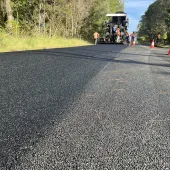Bridges Benefit from the Best of Asphalt Technology

First published in the January 2016 issue of Quarry Management
Exceptional asphalt mixtures incorporating resilient aggregates and high-performance binders are invariably needed for that most challenging of applications: the surfacing of heavily trafficked bridge decks. Two recent examples are the Dartford Crossing and Doncaster’s St George’s Bridge
Summer 2015 saw two major bridge structures resurfaced with high-performing asphalts intended to ensure intervention-free operation for years to come. Dartford’s Queen Elizabeth II crossing used Aggregate Industries’ ‘Supreme’ brands of asphalt, while St George’s bridge in Doncaster was surfaced with ‘Steelflow’ from specialist asphalt company Steelphalt.
All the materials at both sites contained state-of-the-art polymer-modified bitumens (PMBs) from Nynas that are renowned for their contribution to demanding asphalt mixtures. High performance was demanded by the clients for both bridges – M25 & Dartford Crossing operators Connect Plus Services and Doncaster Council respectively – and neither client is expecting any need for maintenance until well into the future.
Queen Elizabeth II bridge
The cable-stayed QEII bridge over the Thames – opened in 1991 and arguably the most critical structure of the UK’s motorway and trunk road network – takes a pounding from traffic, 24h a day, seven days a week. Nevertheless, the new surfacing is expected to last a decade and more, thereby keeping to a minimum the need for any related interventions and interruptions to traffic flow.
Project planning for the £1.9 million resurfacing was started by Connect Plus Services (CPS) and their surfacing contractor Aggregate Industries (AI) in the summer of 2014. The high-performance materials put down on the bridge were a 14mm nominal-sized binder course asphalt and a 10mm sized surface course.
Both are the latest versions of AI’s ‘Supreme’ brand of asphalts that contain a PMB especially developed for the company by bitumen specialists Nynas; and both asphalts represent the very top end of surfacing technology. ‘We devised Nynas Nyspec Supreme specifically for Aggregate Industries’ use in heavy-duty applications,’ said Nynas asphalt support engineer Jukka Laitinen.
‘Sites that have been surfaced with Supreme asphalts have tended to be those commonly subjected to heavy loads on the same wheel tracks over a long period of time,’ said AI’s area technical manager Chris Wingrove.
He cited Brands Hatch racing circuit, Southampton Docks and resurfaced carriageway in the western of the two Dartford Crossing tunnels as sites which have used Supreme asphalts. It is also increasingly the material of choice of clients for bus lanes and stations because of its resilience.
‘These are locations that experience extreme levels of highly channelized traffic. The product has developed over time and is now recognized as a highly effective formula,’ said Mr Wingrove. He added that he has no doubt CPS will be pleased with the performance, over time, of the latest Supreme asphalt on the QEII bridge.
Commenting on the bridge surfacing project in general, CPS construction manager Steve Dodds remarked: ‘Programming was an important consideration, given that there’s often something going on somewhere on the M25 and the surrounding network.
‘This summer, in the Dartford area of the M25, we have had the Dart Charge remote charging improvement works under way and Highways England’s Junction 30 upgrade starting to the north. We also knew of Transport for London’s resurfacing planned for the Blackwall Tunnel approaches in August (where, incidentally, AI also laid Supreme).’
The outcome was that the Dartford Crossing asphalt project team had to maximize efficiency and, in effect, resurface the 3km long x 19.3m wide bridge in four weeks rather than the initially proposed five. In the event, one of the structure’s traffic lanes would be worked on each night, a second lane being reserved for AI’s plant movements and a third coned off to provide a safety zone. This left one lane open to traffic throughout the night.
‘The first cones would go out at 10pm. Typically, AI would receive the all clear to start planing out the old asphalt surface at 10.45pm,’ said Mr Dodds. ‘All four lanes had to be open again by 5.30am the next morning. Surfacing had to be finished by 3.30am to allow time for the material to cool and for the traffic management to be removed safely. We had a tight working window, but could still get a lot done in that time.’
Programming was based on realistic nightly outputs given that 80mm of the existing surface would be planed off ahead of the resurfacing operation (leaving a protective 20mm on top of the bridge deck waterproofing), which would put back a 50mm thick binder course and 30mm of surface course.
‘We had to be sure whatever volume of material was being planed out could be replaced, so one eye was always on making sure we had sufficient material delivered and lined up ready to be laid. That meant looking out for how the traffic was moving, checking there was going to be no disruption to deliveries,’ said Mr Dodds.
A logistics operation was established to give a level of certainty of supply. Binder course material would come from AI’s Purfleet plant to the north. The surface course was mixed at the firm’s Northfleet site to the south-east, while a third plant that could batch either material was kept on standby in Greenwich.
Each evening, all of AI’s plant, labour and materials gathered at a holding site at Essex Point, just to the north, before moving out on to the bridge that night.
‘What we needed from AI was a guarantee that all would be finished by 5.30am each morning. A steep ‘paymech system’ was in place if we went over the working window set by Highways England,’ said Mr Dodds.
‘In the event, we had no issues at all with the volumes and quality of material laid.’ Outputs started at about 340 tonnes, covering 500m of resurfacing by one gang, which ramped up to about 1km from 680 tonnes laid by two crews for six nights. Mr Dodds added: ‘We suffered a plant failure during just one shift, when the output dropped to about 300 tonnes, but we made it up the following night.’
St George’s Bridge
Doncaster’s A19 St George’s Bridge allows 44,000 vehicles a day to cross the East Coast Main Line, the River Don and the Don Navigation Canal, into and out of the town. Locally, it is a very important structure. Last summer its role as the town centre’s crucial northern gateway was acknowledged by local authority Doncaster Council (DC) when it chose to change the bridge deck’s surfacing to a very different material from that used before.
Previously, a porous asphalt had surfaced the crossing. This time the decision was taken to move to a dense binder layer topped by a special thin surfacing displaying both enhanced durability and high resistance to skidding. The surfacing chosen, Steelflow, contains a very hard aggregate – the clue being in the name.
‘Steelflow is a mixture of 6mm steel slag aggregate and a tough but very flexible polymer-modified binder. The aggregate is slightly alkaline, the binder slightly acidic, an affinity for each other that helps produce an outstanding asphalt,’ explained asphalt producer Steelphalt’s commercial manager, Dean Raynor.
Steelphalt receive and process steel slag from a number of steelworks, turning the material into a durable aggregate equivalent to stone with a PSV of 63. ‘We’ve put a lot of work into developing our own proprietary asphalt products over time and Steelflow – with its sustainability credentials and high value – is gaining a good reputation here in South Yorkshire,’ said Mr Raynor.
St George’s Bridge represents the first use of Steelflow on a major elevated structure. Binder suppliers Nynas assisted Steelphalt with the design of their product and confirmed the suitability of the selected bitumen, Nypol S89, for use in bridge surfacing. ‘Nypol S89 is one of our highest-selling polymer-modified binders: its characteristics suit a wide range of asphalt mixtures and applications,’ said Jukka Laitinen.
‘The binder is engineered to provide (especially in a mixture such as Steelflow) enhanced flexibility as well as extra resilience. Long viaducts, by their nature, can be a little ‘lively’; that is, they move up and down under load. This can challenge conventional asphalts. That said, Steelflow is an exceptionally competent product and I’d say an ideal choice for St George’s Bridge.’
Another factor behind the decision to specify Steelflow surfacing for the structure was, undoubtedly, the generally positive report from transport research consultancy TRL following its investigation of the use of various materials developed by Steelphalt. TRL’s assessment included visual inspections of in-service sites, skid-resistance surveys using SCRIM and laboratory testing. The in-service sites assessed were in Rotherham (laid in 2011), Flouch and Dodworth (both laid in 2013).
‘Visual inspections last year found the materials to be in good or excellent condition,’ said TRL senior researcher in technology development Stuart McRobbie. ‘Speaking specifically about 6mm Steelflow, SCRIM surveys showed that the skid resistance demonstrated by the material was higher, by a significant margin, than the Investigatory Level (as per the Design Manual for Roads & Bridges) for any of the site categories on which it was laid.’
The dual-carriageway St George’s Bridge was built by Amec and opened in 2001. Some 620m long, the 15-span structure climbs to a maximum height of 10.3m above ground level. A composite concrete deck sits on permanent precast concrete formwork laid longitudinally between steel cross girders; which in turn gain support from twin longitudinal steel main girders spanning between reinforced concrete columns founded on piles.
Doncaster Council scheduled the asphalting work plus bridge joint replacement to be carried out in three phases: phase one, involving accommodation works to St George’s Bridge and local roads; phase two, the resurfacing (undertaken in June); and phase three, the bridge joint replacement, to take place over 10 weeks.
The £500,000 contract to remove the porous asphalt and resurface the bridge deck was won by local road surfacing and civil engineering company Derek Lewis. ‘We’re a medium-sized firm moving upwards with the market and chasing evolving technology,’ commented managing director Tom Lewis. ‘So we were very happy to have won this particular contract. It amounted to around 15,000m² of asphalt in all, all of it laid at night to suit traffic management and maintain traffic flows.’
Traffic management was based throughout the summer on two lanes of St George’s Bridge always being available for in- or out-of-town-bound vehicles; with the nearby old North Bridge carrying vehicles travelling in the opposite direction.
Resurfacing of St George’s Bridge’s carriageways involved 50mm of conventional binder course and 20mm of Steelflow. This was 5mm or so thicker than Steelflow was originally designed to be laid. An early selling point of the material was that it could be put down really thin at 15mm to restore a carriageway’s impermeability, ride quality and resistance to skidding while still providing exceptional durability and longevity – at least cost.
This dates back several years to when Rotherham Metropolitan Borough Council (RMBC) asked Steelphalt for an asphalt of high performance but minimal thickness – RMBC was seeking a substantially greater area of surfacing for its spend on a particular volume of asphalt. Steelflow with 6mm steel slag aggregate and Nynas Nypol S89 was the result.
Back at St George’s Bridge, Tom Lewis had good things to say about the asphalt. ‘Steelflow requires care in laying but the effort pays off,’ he said. ‘Once finished and rolled, the job looks really great. The Steelflow is very binder rich and seems like a really durable material.’
DC’s director of regeneration and environment, Peter Dale, speaking at the time the contract was carried out, said: ‘We recognize that St George’s Bridge is the main northern gateway into and out of Doncaster town centre, and that’s why we are undertaking a comprehensive carriageway improvement programme. Once complete, this key part of our road network will provide an enhanced travel experience for road users, will be future-proofed and resilient…(to) cope with future emergency incidents as well as Doncaster’s predicted growth…free from maintenance for many years to come.’
- Subscribe to Quarry Management, the monthly journal for the mineral products industry, to read articles before they appear on Agg-Net.com








